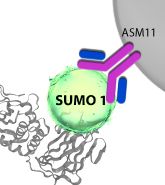SUMOylation 2/3 Affinity Beads
As part of the Signal-Seeker™ product line, SUMOylation 2/3 affinity beads have been optimized in order to detect endogenous levels of SUMO 2/3 modified proteins, which often represent <1% of the target protein. SUMOylation 2/3 affinity beads comprise an anti-SUMO-2/3 antibody (Clone 11G2) that has been chemically conjugated to Protein G beads. Validation studies done in Hela cells have shown that these beads can immunoprecipitate a wide range of SUMO 2/3 modified proteins without detectable leaching of either heavy or light chains in an IP assay. A comprehensive Signal-Seeker™ SUMOylation 2/3 Detection Kit is also available (BK162) and is recommended for first time users.
Validation Data: SUMOylation 2/3 Affinity Beads White Paper
Each lot of affinity-bead is quality controlled to provide high batch to batch consistency, see COA documents.
Validated Applications
Immunoprecipitation using the Signal-Seeker™ SUMOylation 2/3 Detection Kit
Denatured cell lysates were prepared as previously reported1 from HeLa cells ("HS43": Heat Shock treated 42°C for 10 min, and "CT37": untreated) and HeLa siRNA SUMO knockdown ("KDS2"). 1mg of lysate was used for the immunoprecipitation (IP) of SUMOylated 2/3 proteins. Western blots of immunoprecipitated proteins were developed using anti-SUMO-2/3 antibody (Cytoskeleton cat# ASM23) (A) or anti-Ubc9 antibody (B). The level of SUMO-2/3 conjugates in heat shock treated cells is higher than control, and shRNA SUMO-2 knock-down reduced the level of SUMOylated 2/3 modified proteins. Chemical conjugation of SUMO-2/3 antibody (11G2) to the affinity bead matrix prevents heavy and light chain leaching. Unconjugated free SUMO is also captured by the SUMO-2/3 affinity beads.
(B) Unmodified Ubc9 is visible near 18kDa. High molecular-weight band indicates that Ubc9 is SUMOylated by a single SUMO-2/3 protein. Ubc9 has previously been reported to be a target for SUMOylation1,2.
1. Barysch S. et al. 2014. Identification and analysis of endogenous SUMO1 and SUMO2/3 targets in mammalian cells and tissues using monoclonal antibodies. Nat Protoc. 9(4):896-909
2. Becker J. et al. 2013. Detecting endogenous SUMO targets in mammalian cells and tissues. Nature Struc. & Mol. Biol. 20, 525-531.

Amount:
Each package contains enough SUMOylation 2/3 beads for 20 reactions.
For more information contact: signalseeker@cytoskeleton.com
Associated Products:
Signal-Seeker™ SUMOylation 2/3 Detection Kit (Cat. # BK162)
Signal-Seeker™ Ubiquitination Detection Kit (Cat. # BK161)
Signal-Seeker™ Phosphotyrosine Detection Kit (Cat. # BK160)
Signal-Seeker™: BlastR™ Rapid Lysate Prep Kit (Cat. # BLR01)
Signal-Seeker™: PTMtrue™ SUMOylation 2/3 Antibody (Cat.# ASM23)
For product Datasheets and MSDSs please click on the PDF links below.
Click on the pdf icon below to download the manual ![]()
Certificate of Analysis: Lot 021
If you have any questions concerning this product, please contact our Technical Service department at tservice@cytoskeleton.com
Visit our Signal-Seeker™ Tech Tips and FAQs page for technical tips and frequently asked questions regarding this and other Signal-Seeker™ products click here
If you have any questions concerning this product, please contact our Technical Service department at tservice@cytoskeleton.com










